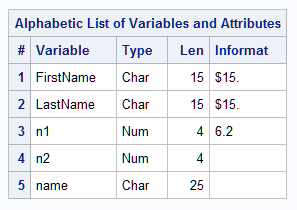LENGTH Statement
Specifies the number of bytes for storing variables.
| Valid in: | DATA step |
| Category: | Information |
| Type: | Declarative |
| See: | LENGTH Statement under Windows, UNIX, and z/OS |
| CAUTION: |
Avoid shortening
numeric variables that contain fractions.
The precision of a
numeric variable is closely tied to its length, especially when the
variable contains fractional values. You can safely shorten variables
that contain integers according to the rules that are given in the
SAS documentation for your operating environment, but shortening variables
that contain fractions might eliminate important precision.
|
Syntax
Arguments
- variable-specification
-
is a required argument and has the form
- variable
-
specifies one or more variables that are to be assigned a length. This includes any variables in the DATA step, including those dropped from the output data set.Restriction: Array references are not allowed.Tip:If the variable is character, the length applies to the program data vector and the output data set. If the variable is numeric, the length applies only to the output data set.
Details
Subject to the rules
for assigning lengths, lengths that are assigned with the LENGTH statement
can be changed in the ATTRIB statement and vice versa. See SAS Variables in SAS Language Reference: Concepts for information
about assigning lengths to variables.
Example
This example uses a
LENGTH statement to set the length of the character variable NAME
to 25 bytes. The LENGTH statement also changes the default number
of bytes that SAS uses to store the values of newly created numeric
variables from 8 to 4 bytes. The TRIM function removes trailing blanks
from LASTNAME before it is concatenated with these items:
If you omit the LENGTH statement,
SAS sets the length of NAME to 32 bytes.
data testlength; informat FirstName LastName $15. n1 6.2; input firstname lastname n1 n2; length name $25 default=4; name=trim(lastname)||', '||firstname; datalines; Alexander Robinson 35 11 ; proc contents data=testlength; run; proc print data=testlength; run;
See Also
For information about the use of the LENGTH statement in PROC steps,
see the Base SAS Procedures Guide.
How Many Characters Can I Use When I Measure SAS Name Lengths in Bytes? in SAS Language Reference: Concepts
Statements:

